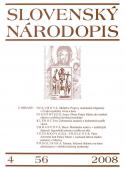Obraz panny Márie ako symbol odporu v poľskej národnej mytológii
Figure of Our Lady as a Symbol of Resistance in Polish National Mythology
Author(s): Anna NiedźwiedźSubject(s): Anthropology
Published by: SAV - Slovenská akadémia vied - Ústav etnológie a sociálnej antropológie Slovenskej akadémie vied
Keywords: Our Lady; national mythology; symbol od resistance; Poland;
Summary/Abstract: It is very interesting to observe that the popular vision of a nation and its past has a very strong religious dimension in the Polish case. Sacred and profane visions of time, cyclical and linear, mythical and real are mixed together. Religious symbols are often tied strictly with the national discourse, that it is difficult to distinguish which symbols are more religious, and which are more national. A good example can be the image of Our Lady of Częstochowa which is often described and treated as a national emblem .Probably the most unique factor (compared to other European countries) of Polish religious life is its inclination to mass rituals, events and gatherings, which attract crowds. Even those who are not regular church goers are often attracted by those mass religious events and participate in them. The fall of Communism in 1989 and huge changes leading toward building a new democratic society brought questions about the role of the Catholic Church as well as about the place of the mythical symbolic discourse which had been present and highly influential during the previous several dozens of years. The last 18 years in fact has not brought answers toward these important questions. What can be observed in Poland is the constant debate and returning discussion about these important issues. Unstable political situation, shifts and changes of political parties and programs, involvement of the Catholic Church hierarchy in many political issues characterize the atmosphere of the political debate (or a political fight). One of the arguments in this debate taken officially or at least unofficially into account is still the importance of mass religiosity. The power of the mass religious movement and its connection with the national mythology is still visible. One of the most popular new Marian shrines built around the old church in Licheń in Central Poland is a very good iconographical example of the complex religious-national mythology and the popularity of its symbolism. In the contemporary social and political situation the presence of religious-national discourse and the mythical symbolism enrooted in the Baroque-Romantic past is seen by many as a kind of burden. In the new circumstances of the democratic state the lack of the identification between the society and the state – seen at the time of the resistance as a value – disturbs the process of democratization. The language of resistance and myth – important in times of threat as a means to consolidate society – now has started to be the source of ideological conflicts and fights. In a time when society faces its own myths and is forced to rediscover and re-discuss its own mythical history (as it happened for instance during the debate about massacre of Jews made by the Poles in Jedwabne town during the WW II, or during the debate about the involvement of Catholic priests and bishops in the Communist security service).
Journal: Slovenský národopis
- Issue Year: 56/2008
- Issue No: 4
- Page Range: 373 - 387
- Page Count: 15
- Language: Slovak

